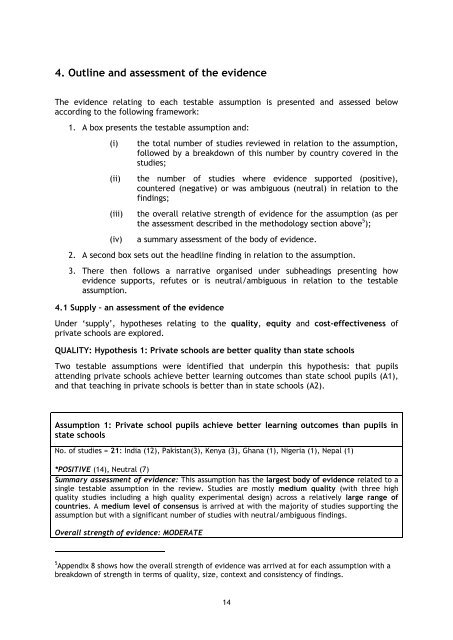private-schools-full-report
private-schools-full-report
private-schools-full-report
Create successful ePaper yourself
Turn your PDF publications into a flip-book with our unique Google optimized e-Paper software.
4. Outline and assessment of the evidence<br />
The evidence relating to each testable assumption is presented and assessed below<br />
according to the following framework:<br />
1. A box presents the testable assumption and:<br />
(i)<br />
(ii)<br />
(iii)<br />
(iv)<br />
the total number of studies reviewed in relation to the assumption,<br />
followed by a breakdown of this number by country covered in the<br />
studies;<br />
the number of studies where evidence supported (positive),<br />
countered (negative) or was ambiguous (neutral) in relation to the<br />
findings;<br />
the overall relative strength of evidence for the assumption (as per<br />
the assessment described in the methodology section above 5 );<br />
a summary assessment of the body of evidence.<br />
2. A second box sets out the headline finding in relation to the assumption.<br />
3. There then follows a narrative organised under subheadings presenting how<br />
evidence supports, refutes or is neutral/ambiguous in relation to the testable<br />
assumption.<br />
4.1 Supply – an assessment of the evidence<br />
Under ‘supply’, hypotheses relating to the quality, equity and cost-effectiveness of<br />
<strong>private</strong> <strong>schools</strong> are explored.<br />
QUALITY: Hypothesis 1: Private <strong>schools</strong> are better quality than state <strong>schools</strong><br />
Two testable assumptions were identified that underpin this hypothesis: that pupils<br />
attending <strong>private</strong> <strong>schools</strong> achieve better learning outcomes than state school pupils (A1),<br />
and that teaching in <strong>private</strong> <strong>schools</strong> is better than in state <strong>schools</strong> (A2).<br />
Assumption 1: Private school pupils achieve better learning outcomes than pupils in<br />
state <strong>schools</strong><br />
No. of studies = 21: India (12), Pakistan(3), Kenya (3), Ghana (1), Nigeria (1), Nepal (1)<br />
*POSITIVE (14), Neutral (7)<br />
Summary assessment of evidence: This assumption has the largest body of evidence related to a<br />
single testable assumption in the review. Studies are mostly medium quality (with three high<br />
quality studies including a high quality experimental design) across a relatively large range of<br />
countries. A medium level of consensus is arrived at with the majority of studies supporting the<br />
assumption but with a significant number of studies with neutral/ambiguous findings.<br />
Overall strength of evidence: MODERATE<br />
5 Appendix 8 shows how the overall strength of evidence was arrived at for each assumption with a<br />
breakdown of strength in terms of quality, size, context and consistency of findings.<br />
14


